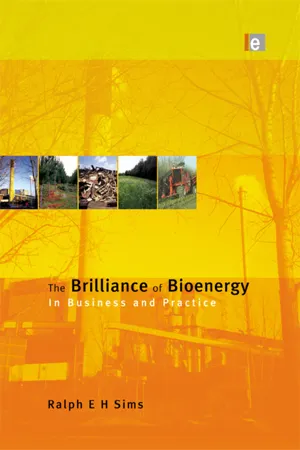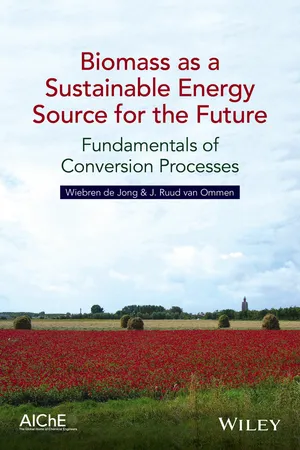Biological Sciences
Biomass Energy
Biomass energy refers to energy derived from organic materials, such as plants, agricultural residues, and wood. It can be converted into various forms of energy, including heat, electricity, and biofuels. Biomass energy is considered renewable because the organic materials used to produce it can be replenished through natural processes.
Written by Perlego with AI-assistance
Related key terms
7 Key excerpts on "Biomass Energy"
- eBook - ePub
The Brilliance of Bioenergy
In Business and In Practice
- Ralph E H Sims(Author)
- 2013(Publication Date)
- Routledge(Publisher)
At the smaller domestic and village community scale, biomass also has good potential as a fuel for micro-turbines and fuel cells (Chapter 10). In all cases environmental issues are key factors, and can be dealt with by developing good practice guidelines and understanding life cycle analysis. A range of socio-economic benefits will also result, particularly at the smaller scale. There seems little doubt that biomass will provide an increasing share of the global primary energy supply, and that in the future new and more efficient bioenergy technologies will continue to be developed (Chapter 11). In the words of Professor David Hall, one of the pioneers of modern bioenergy who sadly died in late 1999 prior to his vision being fulfilled: ‘Biomass is forever.’ So what is biomass? From a renewable energy perspective, biomass can be defined as: recent organic matter originally derived from plants as a result of the photosynthetic conversion process, or from animals, and which is destined to be utilized as a store of chemical energy to provide heat, electricity, or transport fuels. Biomass resources include wood from sustainably grown plantation forests, residues from agricultural or forest production and organic waste by-products from food and fibre industries, domesticated animals and human activities. The chemical energy contained in the biomass is derived from solar energy using the process of photosynthesis (based on the Greek photo, implying to do with light, and synthesis, the linking together of several parts). Photosynthesis is the process by which plants take in carbon dioxide and water from their surroundings and, using energy from sunlight, convert them into sugars, starches, cellulose, lignin etc. These components of vegetable matter are loosely termed carbohydrates, shown chemically for simplicity as [CH 2 O] - eBook - ePub
- Harold Schobert(Author)
- 2013(Publication Date)
- Routledge(Publisher)
10Biomass EnergyMost of the world depends on fossil fuels for both electricity generation and transportation. Two factors will put tremendous pressure on fossil fuel use in the twenty-first century: global climate change, and concerns about resources and geopolitics, especially of oil. These factors make it prudent to consider sources of energy that are not likely to be depleted; such sources are called renewables . Examples include wind, water, solar, and biomass. The term renewables implies that this source is continuously being renewed, either through natural events, as in wind or solar energy, or through human intervention, such as energy crops. Energy sources that are harvested and then regrown are also known as sustainable energy sources . Renewables do not rely on localized concentrations in seams or reservoirs, as fossil fuels, but can be used almost anywhere. Therefore renewables are not nearly so likely to be impacted by concerns of geopolitics and possible embargoes as are the fossil fuels.If there were such a thing as an ‘ideal’ energy source, it would: (1) be essentially limitless, so that we need not worry about the lifetime resources; (2) produce little or no pollution and no radioactive waste; (3) produce no net increase in atmospheric CO2; and (4) be a domestic resource, eliminating any nation's concern about dependence on foreign sources. Various energy sources meet these criteria to some extent; renewables come closest.INTRODUCTION TO BIOMASS
Biomass refers to any type of animal or plant material—i.e., materials produced by life processes—that can be converted into energy or used directly as energy sources. Biomass falls into three categories: wastes (e.g., straw, bagasse, garbage), standing forests (e.g., firewood), and energy crops (e.g., corn grown to produce ethanol). Biomass should be inexhaustible, renewable in the literal sense of the word, provided that we grow a new plant to replace each one harvested for energy. Biomass should have no net effect on atmospheric CO2 , because removal of CO2 by photosynthesis in the growing ‘replacement’ plant should balance CO2 - eBook - ePub
- Paul Breeze(Author)
- 2014(Publication Date)
- Newnes(Publisher)
Chapter 15Biomass-based Power Generation
Abstract
Biomass, usually wood, is an important source of energy in many developing countries where it is used for heating and cooking. The fuel can also be used for power generation. Agricultural, industrial, and urban wastes are cheap sources of biomass fuel. Energy crops can also be grown and used as power plant fuel, but this often competes with land used for food production and can be controversial. Burning the fuel in a combustion plant is the simplest way to convert biomass into electricity, but plants of this type are often small and relatively inefficient. Other methods of using it include co-firing biomass with coal in a coal-fired power station and gasification of biomass. Some animal wastes can be turned into a combustible gas using anaerobic digestion. A biomass power plant can provide power when required unlike intermittent renewable sources such as wind and solar power.Keywords biomass urban waste agricultural waste energy crops wood pellets biomass combustion co-firing biomass gasification anaerobic digestionBiomass is a fuel derived from plants and animals. The material classified as biomass can include wood and wood derivatives, a variety of agricultural and animal wastes, a part of urban waste, and some industrial wastes and by-products.In the past biomass was the most important source of energy for virtually all regions of the globe with societies relying almost exclusively on fuels such as wood and charcoal for heating and cooking. The Industrial Revolution introduced new forms of energy including coal, oil, and eventually electricity, and these have taken the place of biomass across the developed world. However, biomass remains an important fuel in underdeveloped regions. According to the World Energy Council’s Survey of Energy Resources - eBook - ePub
- Volker V. Quaschning(Author)
- 2019(Publication Date)
- Wiley(Publisher)
CHAPTER 12 Biomass – Energy from NatureHumans have been using energy from firewood for at least 790 000 years – ever since Stone Age people discovered how to make fire (Figure 12.1 ). This makes biomass the oldest renewable energy source by a huge margin. In fact, biomass was the most important energy supply worldwide well into the eighteenth century. Even today some countries like Mozambique and Ethiopia use traditional biomass to cover over 90% of their primary energy needs.As the use of fossil energy supplies grew, biomass use was almost non-existent in the industrialized nations. In 2000 the share of biomass in the primary energy supply in countries such as Britain, Germany, and the USA was not even 3%.Figure 12.1People have been using the energy from firewood for thousands of years.Biomass started to become popular again even in the industrialized countries when oil prices began rising dramatically at the beginning of the twenty-first century. In addition to its traditional use in the form of firewood, modern forms of biomass are now being exploited. Biomass is not only used in simple open fires, but also to operate modern heating systems and power plants for generating electricity, as well as to produce combustible gases and fuels.12.1 Origins and Use of Biomass
The term ‘biomass’ refers to a mass of organic material. It comprises all forms of life, dead organisms and organic metabolism products. Plants are able to create biomass in the form of carbohydrates through photosynthesis. The energy needed is supplied by the sun (Figure 12.2 - eBook - ePub
- Sergio C. Capareda(Author)
- 2019(Publication Date)
- CRC Press(Publisher)
4Biomass Energy
Learning Objectives
Upon completion of this chapter, one should be able to:- Enumerate the various biomass resources that may be used for energy conversion.
- Describe the various conversion pathways for biomass feedstock.
- Describe the various procedures for characterization of biomass.
- Describe the various conversion efficiencies that define each biomass conversion pathway.
- Relate the overall environmental and economic issues concerning Biomass Energy conversion systems.
4.1 Introduction
In the future, biomass resources may contribute significantly to satisfying the world's energy requirements. However, in using biomass for energy, we must ensure that we do not also use up food for human consumption. There are various biomass residues that may be used for heat, fuel, and electrical power. There are also numerous Biomass Energy conversion technologies that are now being commercialized. Economics—considering the overall cost of energy conversion, including feedstock costs and transport costs—is the determining factor affecting the widespread use of biomass for fuel and electrical power. Biomass has been used as fuel in many developing countries; this trend will continue because of particular living conditions and the countries' ability to pay for labor. The biomass residues that will likely contribute to a country's energy mix are those that have zero or negative value, such as municipal solid wastes, municipal sewage sludge, and animal manure. Commercial technologies for the conversion of these feedstocks into heat, fuel, and electrical power are slowly being introduced into the market. Deforestation as well as scarcity of land for widespread production affect the use of biomass residues in some developing countries. Following the basic definition of a renewable energy resource, biomass resources must not be used at a rate faster than they are produced. As such, if fuel wood becomes a feedstock for electrical power generation, there must be, in conjunction, a massive reforestation program to replant biomass resources that are continually used each year. For example, for every MW of electrical power energy produced, about 600 hectares [148.2 acres] of forest are needed, assuming 50% conversion efficiency and the productivity of wood as shown in Example 4.1 - eBook - ePub
Biomass as a Sustainable Energy Source for the Future
Fundamentals of Conversion Processes
- Wiebren de Jong, J. Ruud van Ommen(Authors)
- 2014(Publication Date)
- Wiley-AIChE(Publisher)
This chapter describes the global energy situation in terms of expected population development, associated demand for energy supply, and implications of energy supply schemes on the environmental development. A major issue in this respect is climate change, which has been recognized to be partly induced by man’s activities involving utilization of fossil fuels. The GHG effect is described and ways to mitigate its extent. Ways to establish sustainable development include energy savings, utilization of renewable energy sources and clean fossil, and nuclear energy usage. Regarding the second aspect, bioenergy as part of a sustainable energy mix is dealt with in this book. At present, biomass is again valued as an important contributor to secure and clean energy supply and is expected to form a substantial part of the (near) future energy mix. Types of biomass sources and their potential are discussed. In addition, aspects of economy, social context, and environmental impact of biomass for energy supply are illustrated and discussed.Key Concepts
Primary energy demand, different scenarios Population development Relevant emissions from energy conversion processes Global warming Greenhouse gas effect GHG emission mitigation strategies Sustainability (economics, social aspects, and environmental impact) criteria Trias Energetica Biomass availability Biomass source types Conversion processesShort-Answer Questions
- 1.1 How can modern biomass-to-energy conversion technologies mitigate poverty as compared to traditional biomass processing (heating/cooking)?
- 1.2 Which factors limit the RP ratio as a factor to predict how long a fossil energy will be available?
- 1.3 Explain in your own words the greenhouse effect and the human contribution to it.
- 1.4 Why is CO2 the most important anthropogenic source of all greenhouse gases?
- 1.5 Explain why naturally occurring fires to some extent contribute to carbon sequestration.
- 1.6 What are the main sources of methane emissions? What can be done to reduce these?
- 1.7 What are the main sources of N2 O emissions? What can be done to reduce these?
- 1.8 In which ways can mankind adapt to climate change impacts, and which roles can biomass play in such adaptations?
- 1.9 Are there also natural sources that lead to acidification of water?
- 1.10 Show, by means of a chemical reaction equation, how marble is attacked chemically by acid rain caused by SOx emissions.
- 1.11
- eBook - ePub
Energy and the New Reality 2
Carbon-free Energy Supply
- L. D. Danny Harvey(Author)
- 2010(Publication Date)
- Routledge(Publisher)
Figure 4.42 ). This total energy divided by the non-Biomass Energy input gives the EROEI.Figure 4.42Efficiencies in the production of fuels from biomass, computed from the data in the tables presented hereNote: Bars represent efficiencies based on Biomass Energy input only, while the line represents efficiencies based on biomass and non-Biomass Energy inputs. F2006 = Farrell et al (2006), W2007C and W2007N = Wang et al (2007), where N denotes use of natural gas and C denotes use of coal at the ethanol plant, M2004 = Macedo (2004), cited in Smeets et al (2008), P2008 = Pimentel et al (2008), S2005 = (S&T)2 Consultants Inc (2005b), KD2005a = Kim and Dale (2005a), H2005 = Hamelinck et al (2005a), HF2006 = Hamelinck and Faaij (2006), TY2008 = Takeshita and Yamaji (2008).Figure 4.43Relative proportions f bioenergy, agricultural energy and process energy in the production of various fuels and co-products from biomass, computed from the data in the tables presented hereNote: Also given is the energy output, including energy displaced by co-products. See for the key to the reference abbreviations.4.7 Biomass as a Chemical FeedstockBiomass can be used as a feedstock in place of petroleum (and other fossil fuels) for the production of all of the products (or close substitutes) that are currently made from fossil fuels. As most of these products (such as plastics, tyres and solvents) are eventually incinerated or decompose, releasing CO2 to the atmosphere, the replacement of fossil fuel feedstocks with biomass feedstocks will reduce net CO2 emissions (as well as stretch out conventional fossil fuel supplies). Geiser (2001, Chapter 11 ) contains an overview of the many petroleum-based products that can be made from biomass feedstocks. Table 4.40 gives the percentage of different classes of industrial materials that are currently produced from biomass in the US, while Figure 4.44
Learn about this page
Index pages curate the most relevant extracts from our library of academic textbooks. They’ve been created using an in-house natural language model (NLM), each adding context and meaning to key research topics.






